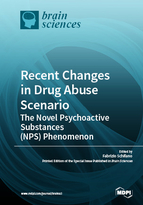Recent Changes in Drug Abuse Scenario: The Novel Psychoactive Substances (NPS) Phenomenon
A special issue of Brain Sciences (ISSN 2076-3425).
Deadline for manuscript submissions: closed (5 March 2018) | Viewed by 141732
Special Issue Editor
Interests: psychopharmacology; addiction; drug misuse; new psychoactive substances
Special Issues, Collections and Topics in MDPI journals
Special Issue Information
Dear Colleagues,
In parallel with a decrease/stabilization in the use of internationally controlled drugs, the market of novel psychoactive substances (NPS) continues increasing, year after year, with the Internet playing a pivotal role in contributing to this complex scenario. At times, although misleading, the terms ‘legal highs’ or ’research chemicals’ have been used to describe these molecules. Overall, about 5% of 19–24-year-old European people have already experimented with them, because both NPS’ intense psychoactive effects and their virtual non-detectability in routine drug screenings. Although ‘novel’ typically refers to molecules that have recently become a reason of current/potential public health concern, at times, the NPS scenario may indeed focus on pharmaceutical molecules. These may have either not entered the market, or are currently prescribed, with their potential for misuse resulting from the relating high dosages/idiosyncratic ways of self-administration. A concurrent use of a range of different NPS, and/or medications, is frequently being reported and this may be a reason of further clinical complications. Given their complex pharmacodynamics, there are increasing levels of concern about the onset of acute/chronic psychopathological associated with NPS intake. This Special Issue aims at providing an overview of a range of NPS-related issues, e.g., preclinical, epidemiological, and clinical pharmacological; the medical and psychopathological consequences associated with their intake; and, finally, the analytical chemistry and forensic analysis challenges associated with the NPS phenomenon.
Prof. Dr. Fabrizio Schifano
Guest Editor
Manuscript Submission Information
Manuscripts should be submitted online at www.mdpi.com by registering and logging in to this website. Once you are registered, click here to go to the submission form. Manuscripts can be submitted until the deadline. All submissions that pass pre-check are peer-reviewed. Accepted papers will be published continuously in the journal (as soon as accepted) and will be listed together on the special issue website. Research articles, review articles as well as short communications are invited. For planned papers, a title and short abstract (about 100 words) can be sent to the Editorial Office for announcement on this website.
Submitted manuscripts should not have been published previously, nor be under consideration for publication elsewhere (except conference proceedings papers). All manuscripts are thoroughly refereed through a single-blind peer-review process. A guide for authors and other relevant information for submission of manuscripts is available on the Instructions for Authors page. Brain Sciences is an international peer-reviewed open access monthly journal published by MDPI.
Please visit the Instructions for Authors page before submitting a manuscript. The Article Processing Charge (APC) for publication in this open access journal is 2200 CHF (Swiss Francs). Submitted papers should be well formatted and use good English. Authors may use MDPI's English editing service prior to publication or during author revisions.
Keywords
- drug abuse
- drug misuse
- novel psychoactive substances
- NPS
- prescribing drugs’ misuse







